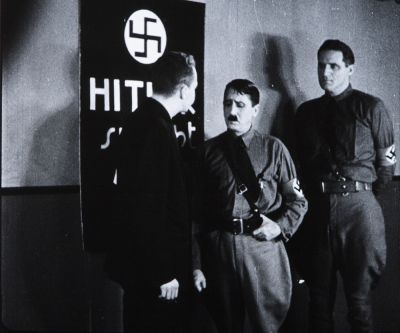
HITLER’S REIGN OF TERROR
(USA/1933) R.: Cornelius Vanderbildt, Mike Mindlin. D.: 55'. V. inglese
T. alt.: Workers' View of Hitler's Reign of Terror. F.: Cornelius Vanderbilt Jr. M.: Sam Rosen. Int.: Edwin C. Hill, Cornelius Vanderbilt Jr., Helen Keller, Samuel Dickstein (se stessi). Prod.: Jewel Productions, Inc.
35mm. D.: 55'. Bn. Versione Inglese / English Version.
Da: Cinémathèque Royale de Belgique
Introduce Nicola Mazzanti (Cinémathèque Royale de Belgique)
Nel 1933, Cornelius Vanderbilt Jr. girò l'Europa con due operatori per intervistare personalità come Stalin e Mussolini. Ovviamente non poteva lasciarsi sfuggire l'occasione di recarsi a Berlino e a Vienna per documentare gli strascichi delle elezioni che segnarono la nomina di Hitler a Cancelliere. Girando liberamente e senza autorizzazioni di sorta, filmò immagini che non venivano mostrate dai cinegiornali ufficiali dell'epoca. Una volta a casa, Cornelius montò questo materiale aggiungendovi spezzoni di cinegiornali, alcune scene (goffamente) rigirate e un commento (letto da una famosa 'voce' radiofonica della CBS) e nell'aprile del 1934 portò sugli schermi Hitler's Reign of Terror. L'analisi di Vanderbilt è inflessibile e straordinariamente precisa: Hitler è un mostro e darà sicuramente inizio a una guerra. Per incredibile che possa sembrare, Cornelius è perfino capace (nel 1933!) di chiedere a Hitler: "E gli ebrei, Vostra Eccellenza?". Inutile dire che l'Ambasciatore tedesco protestò, gli americani temettero ritorsioni economiche da parte dei nazisti e il film ben presto scomparve. Nel 1939 Vanderbilt lo rimontò in una sorta di 've l'avevo detto', ma ancora una volta il film fu ignorato al punto che non parve sopravvivere in alcuna sua parte. Di fatto, un'unica copia su supporto nitrato della versione del 1939 riuscì ad arrivare in Belgio (probabilmente alla ricerca di una distribuzione pochi mesi prima dell'occupazione nazista), non venne reclamata alla dogana e fu infine acquistata dalla Cinémathèque che la conservò felicemente nelle sue fredde stanze, perfettamente intatta come la copia che si credeva conservata in qualche archivio statunitense. In tempi recenti la Cinémathèque ha contattato Thomas Doherty (lo storico del cinema autore del fondamentale Hollywood and Hitler) per ottenere maggiori informazioni sul film, sulle due versioni e sulla sua storia. Solo allora è apparsa evidente la rarità di questa copia e la necessità di preservarla. Grazie anche a Thomas Doherty e alla vedo- va di Cornelius, possiamo finalmente vedere un'opera che non solo contiene magnifiche immagini inedite di Vienna e Berlino all'inizio del 1933, ma svela come il mostruoso pericolo del nazismo e perfino dell'Olocausto fosse già sotto gli occhi tutti, ma l'Europa e gli Stati Uniti decisero di ignorarlo.
Nicola Mazzanti
In 1933, Cornelius Vanderbilt Jr. toured Europe with two cameramen and interviewed personalities such as Stalin and Mussolini. Obviously, he could not miss his chance to go to Berlin and Vienna to witness the aftermaths of the elections that made Hitler Chancellor. Shooting without the proper authorizations and con- trol, he took images that at the time none could see in the official newsreels. Back home, Cornelius used his material, added some newsreel footage, a few (clumsily) reenacted scenes, added a commentary (read by a famous CBS radio 'voice') and in April 1934 brought Hitler's Reign of Terror to the screens. In it, Vanderbilt's analysis is adamant and stunningly accurate: Hitler is a monster and he will surely start a war. Unbelievable as it may sound, he is even able (in 1933!) to ask Hitler "And what about the Jews, Your Excellency?". Needless to say, the German Ambassador protested against the film, the US establishment feared Nazi commercial reprisals, and the film soon disappeared. In 1939 Vanderbilt re-cut the film as a sort of 'I told you' version, but again the film was ignored to the point that no element of the film seemed to have survived. In fact, a unique nitrate print of the 1939 version had found its way to Belgium (probably seeking distribution just months before the Nazi occupation), was left unclaimed at the customs and eventually was acquired by the Cinémathèque to be conserved happily in its cold rooms, untouched as it was thought to exist in some US archive. It was only recently, when the Cinèmathèque contacted Thomas Doherty (the film historian author of Hollywood and Hitler, a must-read) in order to learn more about the film, the two versions, its history, that the rarity of the print and the need to preserve it became evident. Thanks also to Thomas Doherty and to Cornelius' widow, we can finally see a work that not only contain amazing, never seen before images of Berlin and Vienna in early 1933, but shows how the truth about the monstrosity of Nazism and even of the Holocaust was there to be seen by everybody had they not decided, in the US as in Europe, to ignore it.
Nicola Mazzanti
Tariffe:

Numero posti: 144
Aria condizionata
Accesso e servizi per disabili
Il nostro cinema aderisce al circuito CinemAmico: è possibile utilizzare l’applicazione MovieReading® per i film di cui è prevista audiodescrizione e/o sottotitolazione sull'applicazione.
Tel. 0512195311











